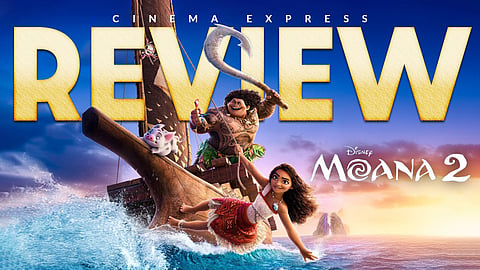Moana 2 Movie Review: Spectacular visuals make up for a plot that is adrift
Moana 2(3 / 5)
Back in 2016, when Moana hit theatres, it opened to a wave of positivity—not because of a redefining narrative. At its core, the film conveyed the age-old message of good triumphing over evil, with the protagonists teaming up to save the world. However, the film was considered enchanting for two main reasons: the Polynesian representation, which opened audiences to ancient fables, and its portrayal of Moana as a female protagonist with a purpose beyond finding a prince. Eight years later, Moana and Maui are back, riding the crest of nostalgia from the first film and making us envious of their perfect hair. Like its predecessor, this sequel brings a familiar tale, but this time it fails to venture into the uncharted territory of storytelling brilliance. The film, however, is still spectacular, thanks to its breathtaking and tide-turning visuals.
Cast: Auliʻi Cravalho, Dwayne Johnson, Temuera Morrison, Nicole Scherzinger, Rachel House, and Alan Tudyk
Directors: David Derrick Jr., Jason Hand, and Dana Ledoux Miller
Lately, Disney has been attempting to go beyond the commercial American narrative by crafting rooted stories from diverse cultures. Beginning with New Zealand representation in Moana, they resonated with Mexicans (Coco), Colombians (Encanto), and Chinese (Turning Red). While this effort from the centenarian production house is laudable, such films can only shine when they dive deeper into their narratives. Moana 2 stays at the shore, repeating a familiar arc: Moana must defeat a villain to save civilisation after receiving a calling from her ancestors. Once again, she teams up with Maui, leading to the most obvious of conclusions—saving the day. While no Disney film is expected to deviate from its triumphant endings, this one could have at least presented fresher conflicts and resolutions.
For instance, as in the first film, when Moana is uncertain about her purpose, her Gramma’s spirit appears to motivate her to traverse the endless blues. Similarly, Maui’s song surfaces at the right moment to lift Moana out of her self-doubt. Even the action sequences are more visually stunning than narratively startling. Maui is saved by Moana's crew in one instance, while Moana is saved by Maui in another, resulting in a predictable exchange of heroics. If you happen to rewatch Moana to jog your memory before the sequel, you might even find similarities in several instances in the storytelling.
Despite these turbulent waters, Moana 2 is not entirely lost at sea. Like any Disney production, it dazzles with its detailed world-building. The sequel introduces Simea, Moana’s younger sister, an endearing character whose design leaves an indelible mark. With her bunny teeth and limited speaking skills, Simea’s charm is a testament to Disney’s mastery in animation. The film plunges us into stormy yet mesmerising worlds. For example, Awhimai Fraser’s song ‘Get Lost’ featuring an unimportant antagonist, Matangi, builds a batwoman's lair in a breathtaking blend of purples and blacks. With bats flying and Matangi and Moana flying along, the world—although adding no value to the film—takes you on an unseen and effervescent journey. Such unique worlds are created for the Kokamora pirates involving a giant clam, a portion set entirely in the Black Sea which is a dark contrast to the bright blue talking sea, and many more instances. With the story being as fictional and mystical as possible, the visual worlds transcend you to vast expanses of shimmering depths with the sparkling tides making you forget the film’s briny portions.
Moana 2 also boasts a dynamic and immersive sound design. When the Kokomora pirates, made entirely of coconuts, communicate, their language is formed by the rhythmic tapping of coconuts—a clever auditory detail. At pivotal moments, such as when Moana sets sail with her crew, we hear chants and hymns in Maori, transporting us beyond the gentle whispers of the waves and deep into the heart of the island culture.
Moana’s purpose in this film feels repetitive and limited, making the sequel a case of two steps forward and one step back. Yet, in a community that trusts their monarchical heiress to guide them toward prosperity, and in which there’s no doubt that a woman will succeed where male ancestors failed, the film delivers a win for female representation. After all, two steps forward and one step back is still one step in the right direction. In a world where the tides of tradition have been shaped by men, Moana proves that the next wave belongs to women—and that, in itself, is a victory worth celebrating.


